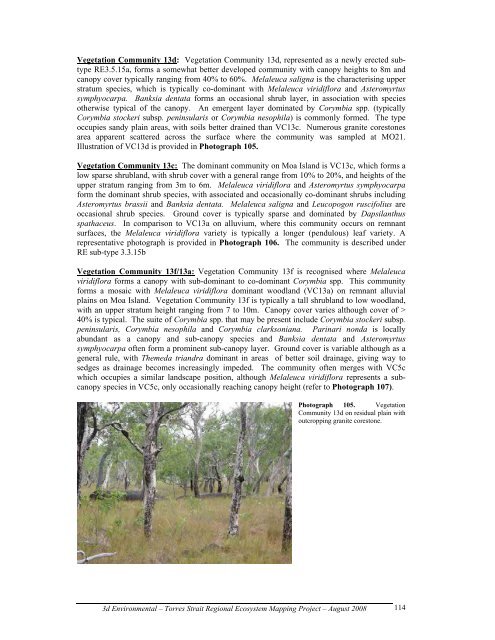Appendix 2 - Vegetation Communities and Regional Ecosystems
Appendix 2 - Vegetation Communities and Regional Ecosystems
Appendix 2 - Vegetation Communities and Regional Ecosystems
Create successful ePaper yourself
Turn your PDF publications into a flip-book with our unique Google optimized e-Paper software.
<strong>Vegetation</strong> Community 13d: <strong>Vegetation</strong> Community 13d, represented as a newly erected subtype<br />
RE3.5.15a, forms a somewhat better developed community with canopy heights to 8m <strong>and</strong><br />
canopy cover typically ranging from 40% to 60%. Melaleuca saligna is the characterising upper<br />
stratum species, which is typically co-dominant with Melaleuca viridiflora <strong>and</strong> Asteromyrtus<br />
symphyocarpa. Banksia dentata forms an occasional shrub layer, in association with species<br />
otherwise typical of the canopy. An emergent layer dominated by Corymbia spp. (typically<br />
Corymbia stockeri subsp. peninsularis or Corymbia nesophila) is commonly formed. The type<br />
occupies s<strong>and</strong>y plain areas, with soils better drained than VC13c. Numerous granite corestones<br />
area apparent scattered across the surface where the community was sampled at MO21.<br />
Illustration of VC13d is provided in Photograph 105.<br />
<strong>Vegetation</strong> Community 13c: The dominant community on Moa Isl<strong>and</strong> is VC13c, which forms a<br />
low sparse shrubl<strong>and</strong>, with shrub cover with a general range from 10% to 20%, <strong>and</strong> heights of the<br />
upper stratum ranging from 3m to 6m. Melaleuca viridiflora <strong>and</strong> Asteromyrtus symphyocarpa<br />
form the dominant shrub species, with associated <strong>and</strong> occasionally co-dominant shrubs including<br />
Asteromyrtus brassii <strong>and</strong> Banksia dentata. Melaleuca saligna <strong>and</strong> Leucopogon ruscifolius are<br />
occasional shrub species. Ground cover is typically sparse <strong>and</strong> dominated by Dapsilanthus<br />
spathaceus. In comparison to VC13a on alluvium, where this community occurs on remnant<br />
surfaces, the Melaleuca viridiflora variety is typically a longer (pendulous) leaf variety. A<br />
representative photograph is provided in Photograph 106. The community is described under<br />
RE sub-type 3.3.15b<br />
<strong>Vegetation</strong> Community 13f/13a: <strong>Vegetation</strong> Community 13f is recognised where Melaleuca<br />
viridiflora forms a canopy with sub-dominant to co-dominant Corymbia spp. This community<br />
forms a mosaic with Melaleuca viridiflora dominant woodl<strong>and</strong> (VC13a) on remnant alluvial<br />
plains on Moa Isl<strong>and</strong>. <strong>Vegetation</strong> Community 13f is typically a tall shrubl<strong>and</strong> to low woodl<strong>and</strong>,<br />
with an upper stratum height ranging from 7 to 10m. Canopy cover varies although cover of ><br />
40% is typical. The suite of Corymbia spp. that may be present include Corymbia stockeri subsp.<br />
peninsularis, Corymbia nesophila <strong>and</strong> Corymbia clarksoniana. Parinari nonda is locally<br />
abundant as a canopy <strong>and</strong> sub-canopy species <strong>and</strong> Banksia dentata <strong>and</strong> Asteromyrtus<br />
symphyocarpa often form a prominent sub-canopy layer. Ground cover is variable although as a<br />
general rule, with Themeda tri<strong>and</strong>ra dominant in areas of better soil drainage, giving way to<br />
sedges as drainage becomes increasingly impeded. The community often merges with VC5c<br />
which occupies a similar l<strong>and</strong>scape position, although Melaleuca viridiflora represents a subcanopy<br />
species in VC5c, only occasionally reaching canopy height (refer to Photograph 107).<br />
Photograph 105. <strong>Vegetation</strong><br />
Community 13d on residual plain with<br />
outcropping granite corestone.<br />
3d Environmental – Torres Strait <strong>Regional</strong> Ecosystem Mapping Project – August 2008<br />
114


